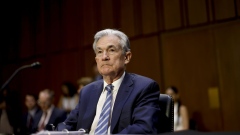Jul 9, 2021
How to keep crypto from crashing the financial system
, Bloomberg News
Cryptocurrency is a 1.7 trillion dollar asset class that’s here to stay: JMP Securities’ Devin Ryan
Once upon a time, the realm of cryptocurrencies was a curious sideshow, a place where criminals did business and enthusiasts dabbled at their own peril. Not anymore. It’s rapidly evolving into a veritable Westworld of finance, where glitchy simulacra of investment funds, banks and derivatives allow visitors to take on immense risks — risks that could ultimately spill over into traditional markets and the broader economy.
Regulators have been struggling to get a grip on all this. It’s increasingly important that they succeed, and soon.
Whether crypto will prove to be, on balance, a good thing is still unclear. As money, it has so far failed: The volatility, transaction costs and carbon footprint of Bitcoin, for example, have made it largely useless for purposes other than speculation and ransomware (and even there it has flaws). That said, the underlying blockchain technology — which allows people anywhere to transact and create indelible records without relying on a trusted intermediary — may yet have uses beyond selling “official” copies of video clips and commemorating the torching of valuable artwork. In due course, it might help sovereign states improve their official currencies.
Lately, though, the denizens of crypto have been replicating the work of traditional financial institutions, without any of the regulatory guardrails designed to keep them in check. Left unattended, this is not likely to end well.
Exhibit 1 is stablecoins, representations of fiat currencies that operate on the blockchain. They mimic bank deposits by purporting to be worth, say, exactly one U.S. dollar per coin. But unlike banks, the organizations that manage them have no deposit insurance, no recourse to emergency loans from the Federal Reserve, and no limits on where to invest the reserves of fiat money that allegedly back them. Tether, the outfit behind one of the most popular stablecoins, has already been caught lending its dollar reserves to its affiliated crypto exchange, and still claims to hold potentially volatile assets such as precious metals and other digital tokens.
History has repeatedly demonstrated how dangerous such a naked combination of deposit-like liabilities and risky investments can be. Even the rumor of losses can trigger a rush to redeem before the money is gone, with systemic consequences. Suppose, for example, stablecoins became large buyers of commercial paper, short-term debt that companies issue for purposes such as buying supplies and paying employees. (Tether says it already holds tens of billions of dollars of such paper.) A sudden wave of redemptions could starve the market of cash, rendering companies unable to make payroll — similar to what happened in 2008, when the bankruptcy of Lehman Brothers triggered a run on money-market funds that devastated the commercial paper market (a vulnerability that itself has yet to be fully addressed).
Exhibit 2 is the burgeoning world of decentralized finance, or DeFi. Working on the Ethereum blockchain, using “smart contracts” capable of automating transactions, often-amorphous teams of developers have set into motion a panoply of applications. These include exchanges, bank-like platforms and derivatives dealers where people can lend, borrow and make highly leveraged bets. Many of the services have decentralized governance systems that leave decision-making to a constantly changing community of users. Scams abound. Hackers frequently find ways to drain funds, as famously happened with the original autonomous blockchain organization, the DAO. Think of it as full-service shadow banking with nobody in charge.
So far, the sums involved are relatively small — the equivalent of tens of billions of dollars, compared with the hundreds of trillions coursing through global capital markets. But this could change quickly, with far-reaching repercussions — particularly given the amount of leverage involved.
Imagine a group of hedge funds making a large bet on cryptocurrency. In DeFi, an algorithm would typically determine how much of their own money, or “margin,” they would have to commit to get a given amount of exposure. This might be 20 per cent, enough to cover a US$20 billion loss on a US$100 billion investment. In the highly volatile realm of crypto, though, setting margins is a tricky business. An error, a hack or a sharp market move could cause the algorithm to recalculate, suddenly requiring the hedge funds to deliver billions more by selling assets in other markets — precisely the kind of contagion that tends to trigger broader meltdowns. And that’s just one of many possible scenarios.
What’s a regulator to do?
One promising solution for stablecoins: Require them to deposit their reserves only in traditional banks, which would in turn park the cash at the Federal Reserve. This would make them equivalent to federally insured deposits, leaving them to compete on the quality of the payment services they provide, as opposed to profiting from unduly risky investments.
Properly regulated, stablecoins could have beneficial uses, such as making it easier and cheaper for migrant workers to send money to their families back home. The payment “rails” they help develop might even someday serve as infrastructure for digital cash issued directly by sovereign central banks.
DeFi will be more complicated. One challenge will be defining what a platform actually does — is it like a bank, an exchange, a securities dealer, something else? Another will be figuring out whom to hold accountable in a decentralized organization — the developers, the users? Multiple agencies will have to cooperate, and new legislation will probably be needed to give them the necessary powers.
The overarching goal should be to ensure similar services are competing on the merits, rather than on the degree of regulation they face or their tolerance for crime. In cases where that’s not possible, some may have to be outlawed.
To their credit, global regulators are aware of the issues and are starting to engage. They’ve thought deeply about the options for addressing stablecoins. They’ve met with DeFi participants to better understand the risks. They’ve set forth concrete proposals to keep traditional banks safe. But they need to act quickly. This could get very big, and very dangerous, very fast.





